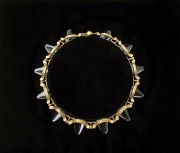Difference between revisions of "Optical glass"
| Line 2: | Line 2: | ||
== Description == | == Description == | ||
| − | A fine grade of [[glass|glass]] used in | + | A fine grade of [[glass|glass]] used in microscopes, telescopes, binoculars, cameras, and other items requiring visual acuity. Primary patents for making optical glass were made in 1798 by P.L. Guinand, a Swiss inventor. Commercial processes for making consistent quality glass were developed in the mid 19th century when the Chance brothers in England introduced the melt-stirring process. Concurrent work in Germany by the Zeiss Company, Ernst Abbe, and Otto Schott established Jena Glass Works as a major supplier of optical glass. Optical glass is clear, flawless, and has a very controlled refractive index. [[Flint%20glass|Flint glass]] produces a higher refractive index and dispersive power while [[soda%20glass|Soda-lime glass]], or [[crown%20glass|crown glass]], produces a lower refractive index and lower dispersive power. Optical glasses are cooled slowly and sometimes annealed for months to minimize distortions. |
== Synonyms and Related Terms == | == Synonyms and Related Terms == | ||
| Line 11: | Line 11: | ||
* Insoluble in all solvents except hydrofluoric acid. | * Insoluble in all solvents except hydrofluoric acid. | ||
| − | * Density = 3.86 g/ml | + | * Density (leaded-glass) = 3.86 g/ml |
| + | * Density (flint glass) = 2.9-5.9 g/ml | ||
* Refractive index = 1.65 | * Refractive index = 1.65 | ||
| − | * Glass transition temperature | + | * Glass transition temperature = ~540 C |
* Warm to touch compared to minerals | * Warm to touch compared to minerals | ||
Latest revision as of 12:24, 19 October 2023
Description
A fine grade of Glass used in microscopes, telescopes, binoculars, cameras, and other items requiring visual acuity. Primary patents for making optical glass were made in 1798 by P.L. Guinand, a Swiss inventor. Commercial processes for making consistent quality glass were developed in the mid 19th century when the Chance brothers in England introduced the melt-stirring process. Concurrent work in Germany by the Zeiss Company, Ernst Abbe, and Otto Schott established Jena Glass Works as a major supplier of optical glass. Optical glass is clear, flawless, and has a very controlled refractive index. Flint glass produces a higher refractive index and dispersive power while Soda-lime glass, or Crown glass, produces a lower refractive index and lower dispersive power. Optical glasses are cooled slowly and sometimes annealed for months to minimize distortions.
Synonyms and Related Terms
crystal; lens; eyeglass; magnifying glass; flint glass
Physical and Chemical Properties
- Insoluble in all solvents except hydrofluoric acid.
- Density (leaded-glass) = 3.86 g/ml
- Density (flint glass) = 2.9-5.9 g/ml
- Refractive index = 1.65
- Glass transition temperature = ~540 C
- Warm to touch compared to minerals
Resources and Citations
- Wikipedia: Optical glass (Access Oct. 2023)
- Encyclopedia Britannica, http://www.britannica.com Comment: "industrial glass" [Accessed May 5, 2004].
- Edward Reich, Carlton J. Siegler, Consumer Goods: How to Know and Use Them, American Book Company, New York City, 1937
- Random House, Webster's Encyclopedic Unabridged Dictionary of the English Language, Grammercy Book, New York, 1997
- The American Heritage Dictionary or Encarta, via Microsoft Bookshelf 98, Microsoft Corp., 1998
